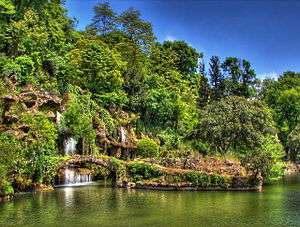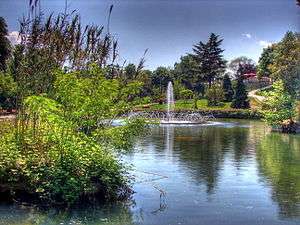Emirgan Park

The Emirgan Park (Turkish: Emirgan Korusu or rarely Emirgan Parkı) is a historical urban park located at the Emirgan neighbourhood in the Sarıyer district of Istanbul, Turkey, on the European coast of the Bosphorus. It is one of the largest public parks in Istanbul.
History
In the Byzantine era, the entire area, where today the park stretches, was covered with cypress trees and known as "Kyparades" or "Cypress Forest". It became known as "Feridun Bey Park", when the uninhabited land was granted in the mid-16th century to Nişancı Feridun Bey, a Lord Chancellor in rank in the Ottoman Empire.[1]
In the 17th century, Ottoman sultan Murad IV (reigned 1623-1640) presented the estate to Emir Gûne Han, a Safavid Persian commander, who surrendered his sieged castle without any resistance, and followed him back to Istanbul.[2] The name "Feridun Bey Park" was changed to "Emirgûne", which in time became corrupted to "Emirgan".[1]
During the centuries, the estate's owner changed several times, and by the end of the 1860s, it was owned by Khedive Ismail Pasha (reigned 1863-1879), Ottoman governor of Egypt and Sudan. The area was used as the backyard of a large wooden yalı that he built on the shore of the Bosphorus. Further, he built within the park area three wooden pavilions, which still exist.[3]
The heirs of the Khedive's family sold the estate in the 1930s to Satvet Lütfi Tozan, a wealthy Turkish arms dealer, who granted the park grounds, the three pavilions included, later in the 1940s to the City of Istanbul during office of Governor and Mayor Lütfi Kırdar (1938-1949).[3][4]
The park today

The park, owned and administered today by the Metropolitan Municipality of Istanbul, covers an area of 117 acres (470,000 m2)[2] on a hillside, and is enclosed by high walls.[5]
Inside the park with two decorative ponds are plants of more than 120 species. The most notable rare trees of the park's flora are: Stone Pine, Turkish pine, Aleppo Pine, Blue Pine, Eastern White Pine, Maritime Pine, Japanese Cedar, Norway Spruce, Blue Spruce, Atlas Cedar, Lebanon Cedar, Himalayan cedar, Beech, Ash tree, Sapindus, Babylon Willow, Hungarian Oak, Colorado White Fir, Maidenhair tree, California incense-cedar, Coast Redwood and Camphor tree.[6]
Many jogging tracks and picnic tables make the Emirgan Park a very popular recreation area for the local people, especially during the weekends and holidays.[2] The three historic pavilions, called after their exterior color as the Yellow Pavilion, the Pink Pavilion and the White Pavilion were restored in time between 1979-1983 by the Touring and Automobile Club of Turkey under its CEO Çelik Gülersoy, and opened to the public as cafeteria and restaurant.[2]
The Emirgan Park is closely associated with the tulip, the traditional flower, which gave its name to an era (1718-1730) of the Ottoman Empire. A special garden was established in Emirgan Park in the 1960s to revive the city's tradition of tulip cultivation. Since 2005, an annual international tulip festival is organized here every April making the park attractive and very colorful with these flowers.[2]
Yellow Pavilion
The Yellow Pavilion (Turkish: Sarı Köşk) is a large wooden mansion in the form of a chalet built by Khedive Ismail Pasha between 1871-1878 as a hunting lodge and guest house.[7]
Situated in the center of the park and overlooking the Bosphorus, the two-storey mansion with one balcony, one terrace and a basement is constructed on an area of 400 m2 (4,300 sq ft).[7] It consists of four rooms, one hall and a kitchen in the lower floor and three rooms and one salon in the upper floor.[8] Its layout reflects the architecture of the traditional Ottoman house with a salon encircled by many living rooms. The ornaments at the ceilings and the walls were the work of the court architect Sarkis Balyan. The ceilings are enriched with oil painted flower figures and the facades with outstanding carvings. The high doors and windows, as well as the opulent interior decorations in bright colors reflect the glory of that era.[7] A pond is situated to the northeast, next to the mansion.
Used only by the owners from the very beginning, the pavilion was restored within four months in the beginning of the 1980s with due diligence, furnished with antiques and opened to the public as a cafeteria.[9] The Yellow Pavilion, the main base of the park, is run since 1997 by Beltur, the tourism company of the Metropolitan Municipality of Istanbul.[7] Up to 100 guests can be served at the premise in summer and winter time.[10]
Pink Pavilion
The Pink Pavilion (Turkish: Pembe Köşk), one of the three mansions in the park built by Khedive Ismail Pasha, is a two-storey, typical Ottoman house. Named after its exterior's original color of cranesbill flower pink, the pavilion reflects the glory of its history with fine ornaments.[8]
The pavilion is used as a cafeteria on weekends. Furthermore, it available for conventions and wedding ceremonies. In the summer months, the premise can accommodate up to 350 guests, for cocktails up to 500 people. In the winter time, groups of up to 150 guests can be served.[10]
White Pavilion
The White Pavilion (Turkish: Beyaz Köşk) is the third mansion within the Emirgan Park built by Khedive Ismail Pasha. It is only 150 m (490 ft) far from the Yellow Pavilion. The two-storey wooden building bears the architectural characteristics of the neo-classical style.[8]
The mansion is used in the daytime as a cafeteria and in the evenings as a restaurant of Turkish-Ottoman cuisine.[11]
See also
References
- 1 2 Saroğlu, Aycan (April 2002). "Spring begins in Emirgan". Skylife: 4–5. Retrieved December 9, 2008.
- 1 2 3 4 5 Şansal, Burak. "Istanbul-Emirgan neighborhood in Istanbul". Great Istanbul. Retrieved December 9, 2008.
- 1 2 "Emirgan Korusu" (in Turkish). Wow Turkey. Retrieved December 9, 2008..
- ↑ "Satvet Lütfi Tozan" (in Turkish). Balkanskidom. Retrieved December 19, 2008.
- ↑ "İstanbul'un Koruları". NTV MSNBC. July 29, 2007. Retrieved December 9, 2008.
- ↑ "Istanbu'un Koruları-Emirgan Korusu" (in Turkish). TAY Projesi. May 27 – June 2, 2007. Retrieved December 9, 2008.
- 1 2 3 4 "Emirgan Korusu 3. Bölüm-Sarı Köşk Hakkında Tarihi Bilgi" (in Turkish). Muhterem'le Geziye. June 8, 2007. Retrieved December 9, 2008.
- 1 2 3 "İş Dünyasının Yeni Mekanı: Köşkler-Sarı Köşk" (in Turkish). Istanbul. Retrieved December 9, 2008.
- ↑ "Çelik Gülersoy". Turing. Retrieved December 9, 2008.
- 1 2 "Sarı Köşk" (in Turkish). Istanbul Restaurants. Retrieved December 9, 2008.
- ↑ "Beyaz Köşk" (in Turkish). Gurme Guide. Retrieved December 9, 2008.
External links
| Wikimedia Commons has media related to Emirgan Park. |
Coordinates: 41°06′30″N 29°03′09″E / 41.10833°N 29.05250°E